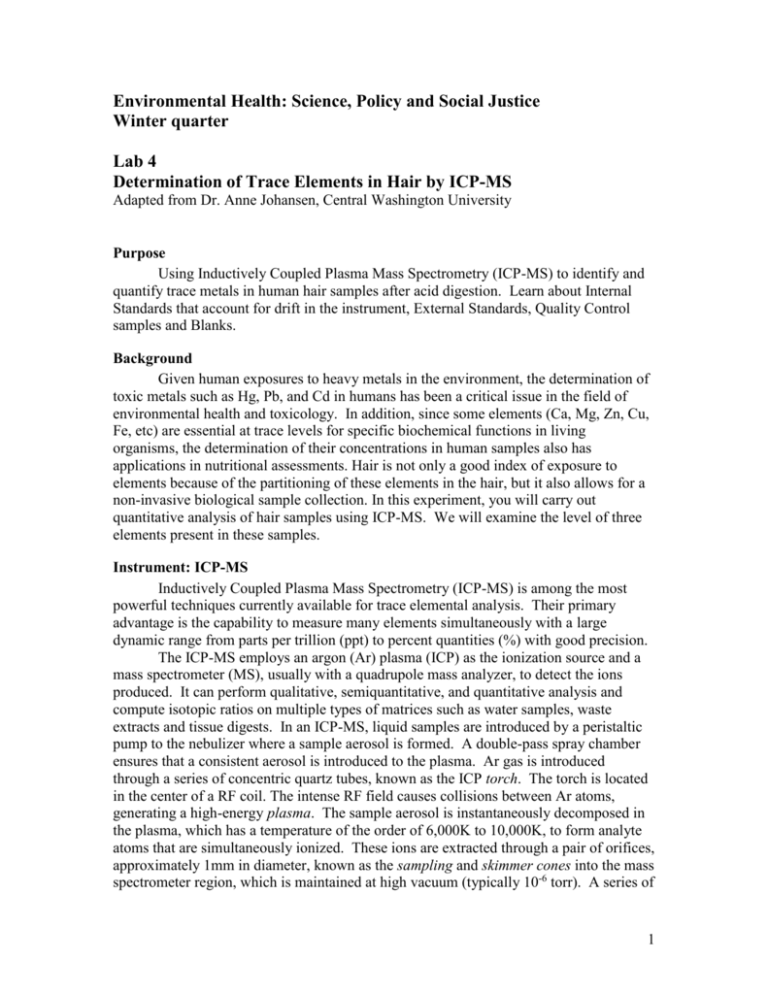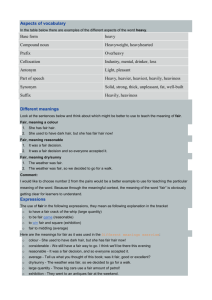Lab IV metals in hair - Evergreen State College Archives and
advertisement

Environmental Health: Science, Policy and Social Justice Winter quarter Lab 4 Determination of Trace Elements in Hair by ICP-MS Adapted from Dr. Anne Johansen, Central Washington University Purpose Using Inductively Coupled Plasma Mass Spectrometry (ICP-MS) to identify and quantify trace metals in human hair samples after acid digestion. Learn about Internal Standards that account for drift in the instrument, External Standards, Quality Control samples and Blanks. Background Given human exposures to heavy metals in the environment, the determination of toxic metals such as Hg, Pb, and Cd in humans has been a critical issue in the field of environmental health and toxicology. In addition, since some elements (Ca, Mg, Zn, Cu, Fe, etc) are essential at trace levels for specific biochemical functions in living organisms, the determination of their concentrations in human samples also has applications in nutritional assessments. Hair is not only a good index of exposure to elements because of the partitioning of these elements in the hair, but it also allows for a non-invasive biological sample collection. In this experiment, you will carry out quantitative analysis of hair samples using ICP-MS. We will examine the level of three elements present in these samples. Instrument: ICP-MS Inductively Coupled Plasma Mass Spectrometry (ICP-MS) is among the most powerful techniques currently available for trace elemental analysis. Their primary advantage is the capability to measure many elements simultaneously with a large dynamic range from parts per trillion (ppt) to percent quantities (%) with good precision. The ICP-MS employs an argon (Ar) plasma (ICP) as the ionization source and a mass spectrometer (MS), usually with a quadrupole mass analyzer, to detect the ions produced. It can perform qualitative, semiquantitative, and quantitative analysis and compute isotopic ratios on multiple types of matrices such as water samples, waste extracts and tissue digests. In an ICP-MS, liquid samples are introduced by a peristaltic pump to the nebulizer where a sample aerosol is formed. A double-pass spray chamber ensures that a consistent aerosol is introduced to the plasma. Ar gas is introduced through a series of concentric quartz tubes, known as the ICP torch. The torch is located in the center of a RF coil. The intense RF field causes collisions between Ar atoms, generating a high-energy plasma. The sample aerosol is instantaneously decomposed in the plasma, which has a temperature of the order of 6,000K to 10,000K, to form analyte atoms that are simultaneously ionized. These ions are extracted through a pair of orifices, approximately 1mm in diameter, known as the sampling and skimmer cones into the mass spectrometer region, which is maintained at high vacuum (typically 10-6 torr). A series of 1 lenses focus the stream of ions into a quadrupole mass analyzer that separates ions based on their charge-to-mass ratio (m/z). Finally, ions are quantified using an electron multiplier and a counter that gives counts per second (cps) for all masses. The mass spectrum generated is extremely simple as each elemental isotope appears at a different mass (e.g. 111Cd would appear at 111 amu whereas 113Cd would appear at 113 amu) with peak intensities directly proportional to the initial concentration of each isotope. In order to determine the absolute concentration of each species in a sample, some sort of calibration needs to be performed that compares cps to a known concentration. For this purpose a series of external standards will need to be made up to be run together with your samples. In addition, an internal standard will be added to each sample in order to track instrument drift. Reagents a. Internal standard stock solution containing 4 ppm Sc and 2 ppm Tm b. External standard stock solution containing 0.5 ppm Ca, 0.01ppm Cu and 0.01ppm Pb c. Concentrated ultra-pure nitric acid (HNO3) d. DI water (ultra-pure water) e. ~ 0.10 g hair samples Procedure (IMPORTANT: use gloves for every part of sample preparation and analysis to prevent metal contamination) a. Preparation of ICP-MS vials (this has already been done for you) Metal ions have a tendency to stick to glass, and glass contains minute quantities of metal ions, therefore glass containers are not appropriate for storing metal ions solutions of very low concentrations. Thus, you will be storing your samples in new 15mL plastic falcon tubes. All glassware has been washed in a 5% HNO3 acid bath for 24 hours (this has been done by our SIT the day before). b. Procedure for the digestion of hair samples The hair samples will be digested before analysis using nitric acid in order to free any bound metals present in the matrix. In order to track any contamination introduced during the procedure or in the nitric acid a DI water sample will be treated the same way as the hair samples. Each student will handle their own hair samples through this procedure. Each pair of students will produce external standards, a QC standard, a method blank, and an instrument blank. Hair sample collection and wash pre-treatment: 1. For hair collection, use ethanol-clean scissors, air-dry briefly and cut a small amount of your hair. For more recent exposure collect hair closer to the scalp. 2. Place approximately 0.12g of hair in a pre-weighed and pre-labeled 50ml acidwashed beaker. 2 3. Prepare your method blank here and treat in the same way through the procedure 4. Cover hair in 15ml of 0.1% Triton X 100 solution (pour from bottle into beaker), sonicate for 10 min 5. Pour Triton-X 100 out of beaker keeping the hair in with the help of a glass rode. Rinse hair with DI water three times, decanting between each 6. Cover hair with 15ml reagent grade acetone, sonicate for 10 min 7. Pour off acetone, let hair dry in the oven at 40oC for 5mim or until dry 8. Allow the beaker to come to room temperature before proceeding Acid digestion of hair samples: 9. Weigh your beaker and hair again and leave 0.1 g of hair, or record the exact weight if close but not exact 10. In the beakers, cover hair aliquot with 10ml conc. HNO3 11. Cover the beaker(s) with a watch glass 12. Place beaker(s) on a hot plate, adjust heating to a gentle boil record hot plate model and setting 13. Digest hair until the hair is dissolved and the solution looks clear (~20min). Do not walk away… While you wait go to “External Standard preparation” and follow steps to prepare your standards. 14. Do not let the beaker(s) go dry. Add more acid if needed. Record all additions. 15. When the digestion is complete, and the hair has fully dissolved, remove the lid and reduce the volume to approximately 3ml. 16. Take the beaker off the hot plate, turn the hot plate off, and let it cool down to room temp inside the hood. 17. Add 1 ml of 30% H2O2 in each sample and put the watch glass back on 18. Heat again on hot plate at the lowest setting (first setting) just until bubbling stops 19. After the bubbling has stopped, take the watch glass off and increase heat as needed until volume is reduced to 2.5ml. 3 20. Quantitatively transfer the contents of each beaker to a new or cleaned falcon tube: pour contents into falcon tube, rinse with water 3x (1.5ml each) and add to falcon tube – make sure that volume doesn’t exceed 9ml. 21. Add required amount of internal standard to final concentrations: 40 ppb for Sc and 20 ppb for Tm. 22. Top up to 10.0000g (mass) with DI H2O, label well and store in the fridge until ready to analyze. 23. If the sample seems cloudy, it is advisable to filter the sample to prevent clogging the nebulizer. Filters will be shown in lab. Matrix of sample, standards (externals and QC) and blanks 25% of concentrated HNO3 acid Mixed internal standards of Sc at 40 ppb and Tm at 20 ppb DI water Mixed Internal Standard Stock Sc serves as the internal standard for Ca, Cu and Tm as the internal standard for Pb. Stock internal standard contains Tm 2 ppm and Sc 4 ppm Mixed External Intermediate Standard Stock The mixed external standard “intermediate” stock contains: Cu at 0.01 ppm Pb at 0.01 ppm Ca at 0.5 ppm External standards External standards will be prepared during the time you wait for the hair digest. You need to prepare a series of five concentrations of each element that you will be detecting. Weigh a clean falcon tube (15ml) tube Add an appropriate volume of the intermediate external standard stock volume to obtain a desired final concentration of Pb and Cu at (0.01, 0.25, 0.5, 0.75, 1 ppb) and Ca at (0.5, 12.5, 25, 37.5, 50 ppb). You will do this by weight, using a balance instead of relying on the accuracy of your pipette. Record exact mass of added stock. Add appropriate volume of internal standard to final concentrations of 40 ppb Sc and 20 ppb Tm and enough nitric acid to final 25% and bring the mass to final of 10gr (by weight) with DI water. Record exact mass. QC standard preparation 4 The QC standard is used to check the accuracy of the external standards. In a professional lab it would be purchased from a secondary source. The provided QC stock solutions are from a different source than the external standard stocks. Within your team of two, one of you must do the calculations and make the QC standard and the other should make the external standards. The QC standard is prepared from the mixed QC intermediate stock solution to a final concentration that is midway in the calibration curve. The concentration of Cu and Pb in the stock is 10 ppb and 500ppb for Ca. The QC solution should be prepared in the same manner as the external standards: by weight, using a balance instead of relying on the accuracy of your pipette. The final concentrations of Pb, Cu, and Ca in the QC standard will be at 0.3ppb, 0.3ppb, and 15ppb respectively. Record exact mass of added stock and exact final mass. Blanks: 1. Undigested subtraction blank (matrix only) 2. Method blank: digested blank (everything except hair) and goes through the digestion process ICP-MS Analysis (this part will take place when scheduled with Jenna) All samples should be at room temperature and well mixed. Place all the standards and your samples in the ICP-MS autosampler tray. Your SIT will demonstrate the basic operation of ICP-MS, autosampler and the software used for data collection. Under no circumstance, should you operate the instrument without the permission of the SIT. Note: before your appointment for the ICP-MS analysis, calculate the actual concentrations for external standards and QC standards using the recorded exact mass from your notes. Data Analysis – Due a week after lab 1. First, find the detection limit for each element by averaging the three blank measurements and adding 3 times the standard deviation: LOD = average(blank) + 3StDev When interpreting the data in the following steps make sure that the values you are discussing were above that detection limit in the raw data. 5 2. The raw data (intensity counts) need to be corrected for the blank, dilutions you made and how much sample you actually used. Concentration = IntensitySample IntensityBlank IntensityInternSt. IntensityInternSt. 3. For all hair samples, record the concentrations of the three elements that you are testing for. Make one comparative bar graph showing these three elements in your hair sample. 4. Discuss the results plotted above. Are these metals within the expected limits? Find expected or normal range of concentrations for these elements. 5. Compare the results of DI water (which is the blank in the calibration) and the average of the digested DI waters. Rationalize your observation. 6. Has the QC sample confirmed the validity of the external standards? Explain your answer. 7. With hair being a biological specimen that may have been treated with chemicals, what kind of bias can you predict in your samples? 6 Informed Consent Release The Environmental Health: Science, Policy and Social Justice program at Evergreen State College is giving you the opportunity to participate in a laboratory exercise in which you will analyze a small amount of your own hair for the presence of a heavy metal (lead, Pb) and two essential trace elements (calcium, Ca and copper, Cu), using Inductively Coupled Plasma Mass Spectrometry (ICP-MS). It is a method by which a number of elements can be detected in extracts of a variety of matrices, e.g. water, soil, biological samples, etc. ICP-MS has extensive applications in environmental analysis. In this laboratory protocol, you will be taking a sample from your own hair. The process is completely non-invasive and requires that you only cut a piece of hair using ethanol-clean scissors. Because a pair of scissors is a sharp object, there is a small risk of puncture if not carefully used. Ethanol is used to prevent any risk of infection to you from potential laboratory biological agents and from person-to-person transmission of pathological agents, such as bacteria, viruses. You will then follow a process of sample digestion with 5% nitric acid. Regular laboratory protective clothing, goggles and gloves are required while handling this solution. Detection of lead in hair samples indicates environmental exposure but not necessarily a health effect. Detection of Ca and Cu in hair is expected since these are essential elements in humans and are normally detected in hair. The results of this particular laboratory exercise are for teaching purposes only and will NOT be used for any diagnostic or identification purposes. Your privacy will be protected. Your hair sample will be discarded after the lab exercise. Participation in the lab is required for full program credit but using your own hair material is voluntary. Please let the faculty know if you opt not to use your own hair and we will provide you with another source of sample to use in the procedure. By signing this permission form, you are agreeing to participate in this exciting learning experience using your own hair sample. If you have any concerns or questions, please contact Maria Bastaki at x5264. Print Your Name ___________________________________ Your Signature __________________________________ Date: ____________ 7








